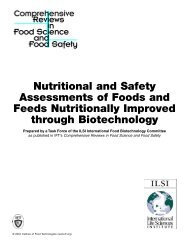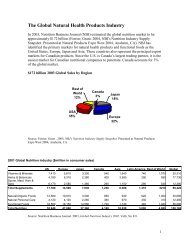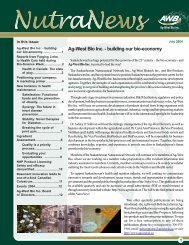Beyond Borders: Global biotechnology report 2010
Beyond Borders: Global biotechnology report 2010
Beyond Borders: Global biotechnology report 2010
You also want an ePaper? Increase the reach of your titles
YUMPU automatically turns print PDFs into web optimized ePapers that Google loves.
Ontario-based firms raised over US$400<br />
million, more than any other province (due<br />
principally to the Biovail financing discussed<br />
above), followed by Quebec firms, which<br />
raised US$161 million. In a surprising show<br />
of strength, Alberta companies raised<br />
US$84 million, while British Columbia’s<br />
firms raised US$67 million.<br />
There was a similar surprise in the cross-city<br />
analysis of capital raised. While Montreal,<br />
Vancouver and Toronto continued to lead<br />
the pack, companies in Calgary raised<br />
US$84 million, third only to Montreal and<br />
Toronto. The increase in funding from<br />
Calgary can be attributed to Oncothyreon<br />
and ResVerlogix, which were both very<br />
active in 2009 and accounted for 56% of the<br />
funding in Calgary.<br />
Australia<br />
In Australia, the amount of capital raised by<br />
publicly traded companies through equity<br />
financings rebounded sharply, from A$119<br />
million (US$106 million) in 2008 to A$307<br />
million (US$229 million) in 2009. While<br />
this represents an encouraging recovery<br />
over the prior year, the amount raised in<br />
2009 is still the second-lowest in any year<br />
since 2002 and is about 40% lower than<br />
the annual average seen between 2005<br />
and 2007. The capital markets remained<br />
closed to biotech companies looking to<br />
issue shares for the first time, and there<br />
were no IPOs of Australian companies<br />
during the year.<br />
As in many markets, the bulk of the<br />
money went to a relatively small group of<br />
companies. Five firms — Avexa, Bionomics,<br />
Pharmaxis, QRxPharma and Starpharma<br />
Holdings Limited — accounted for more<br />
than half the public equity capital raised<br />
during the year. Melbourne-based Avexa<br />
led the financing totals for the year, with<br />
A$41 million (US$31 million) raised in<br />
Australian biotech public equity raised, 2002–09<br />
IPO<br />
A$m<br />
700<br />
600<br />
500<br />
400<br />
300<br />
200<br />
100<br />
0<br />
2002 2003 2004 2005 2006 2007 2008 2009<br />
Source: Ernst & Young, Bioshares and company annual <strong>report</strong>s<br />
several different offerings. Following the<br />
failed merger with Progen in early 2009,<br />
Avexa turned to its shareholders and<br />
raised A$17 million (US$12.7 million)<br />
in a rights issue followed by an A$11<br />
million (US$8.2 million) private placement<br />
and a A$15 million (US$11.2 million)<br />
oversubscribed shareholder purchase<br />
plan. These funds were utilized to advance<br />
the company’s apricitabine (ATC) Phase III<br />
study in HIV patients. The A$15.6 million<br />
(US$11.6 million) raised by Starpharma<br />
through a private placement to<br />
institutional and sophisticated individual<br />
investors is to be used to finance the<br />
completion of Phase III clinical trials.<br />
Other markets<br />
Follow-on offerings<br />
For noteworthy financing events in<br />
other markets, refer to the Country<br />
profiles section.<br />
Number of transactions<br />
Getting creative<br />
Challenging times have typically inspired<br />
creativity in biotech companies, so it is not<br />
surprising that companies have shown an<br />
increased interest in other sources of capital<br />
as the usual funding sources have become<br />
increasingly constrained. This has ranged<br />
from using asset sales and alliances to raise<br />
capital to exploring funding options from<br />
disease foundations and government grants.<br />
Economic development incentive programs<br />
(see A closer look on the next page) provide<br />
another potential source of capital, as state<br />
and local governments — pressures on their<br />
own coffers notwithstanding — are often still<br />
interested in developing their local<br />
biotech clusters.<br />
Looking ahead<br />
The amount of investment capital available<br />
for the biotech industry will depend on<br />
the pace of economic recovery in the<br />
73<br />
70<br />
60<br />
50<br />
40<br />
30<br />
20<br />
10<br />
0








